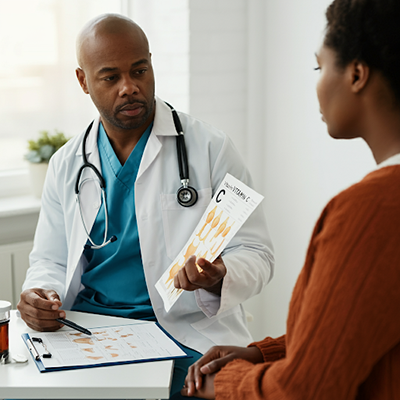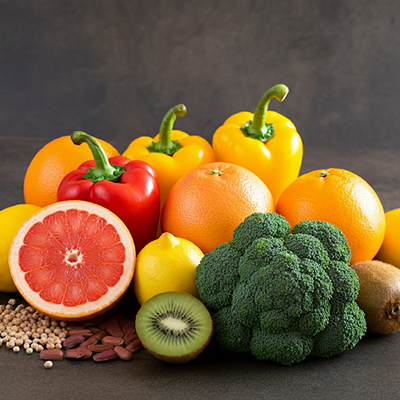Contents
Adele Davis said that vitamin C could cure every disease. That may be an overstatement, yet she was a deep student of nutrition as it conveys disease. Vitamin C is intricate in all vital functions of the body. It is needed for the production of collagen (” cell cement”), the main protein element of the body; it literally holds your body together. This is because it is the basis of connective tissue, cartilage, tendons, etc. Vitamin C is also important in manufacturing certain syntheses and the absorption and utilization of other nutritional factors.

It is an extremely important antioxidant. It strengthens various immune functions by enhancing white blood cell function and activity and elevating interferon levels, antibody reactions, and secretion of thymic hormones. It also resists chemical stress factors, such as water and air pollutants. The adrenal and thyroid glands need it, and it protects against all types of physical and mental stress. It is a natural antibiotic. Wonderful in dealing with fevers and infections. Used for gastrointestinal problems and treating rattlesnake bites. Counteracts poisonous effects of drugs.
Vitamin C is extremely helpful in treating asthma, other allergies, atherosclerosis, high cholesterol, high blood pressure, cataracts, Parkinson’s disease, skin ulcers, wound healing, and pregnancy-related conditions. It can also overcome cadmium poisoning. Cancer patients should be urged to take lots of vitamin C. A book could be written about what vitamin C can do in the body to help you get and stay healthy. It is vital in treating a lengthy list of physical disorders and diseases.
Whether in sickness or health, you can always know when you are getting too much vitamin C: If your body is saturated with it, the extra will be excreted in the bowel, i.e., you will have temporary diarrhea. So you can never take too much. Of course, you need far greater amounts when you have an infection.
So, when you are ill, take vitamin C “to bowel tolerance”; that is until it produces a mild diarrhea effect. Keep in mind that when you are sick, it will only be a few hours, and you may need another large dose of vitamin C. The white blood cells use vitamin C to fight and destroy germs in the system, so do not be skimpy on C when you are ill.
Types of supplements
Vitamin C from the health food store comes in several forms: powders, crystals, capsules, tablets, and timed-release tablets. Ascorbic acid is the most broadly used and least expensive. It is usually made from corn. Buffered vitamin C has sodium, magnesium, calcium, or potassium in it to reduce the immediate acidity of the vitamin C in the mouth and stomach. Sodium ascorbate may not be good for you since it is best to eat little sodium. Then there is “corn-free” vitamin C, made from the sago palm. This also works well and is for those who do not have problems eating corn products.
Ester-C is a new, more expensive product which, it claimed, is absorbed more easily. However, tests reveal that this claim is not correct. Taking supplements containing vitamin C and bioflavonoids would be helpful, except that most do not contain enough bioflavonoids to increase absorption of the vitamin. The level of bioflavonoids needs to be equal to or greater than the C content. For most people, plain ascorbic acid is the best; by far, it is the least expensive and with research-proven effectiveness.
Vitamin C complex sources

The very richest sources are acerola, guavas, red sweet peppers, kale leaves, parsley, collard leaves, turnip greens, green sweet peppers, broccoli, Brussels sprouts, and mustard greens. Good sources are all fresh fruits and vegetables (especially green, leafy vegetables). Early explorers learned that to avoid scurvy, they needed to eat oranges, lemons, limes, berries, or (as the French explorer Cartier did in 1856) spruce tree needles.
Deficiency symptoms
Soft gums (pyorrhea), tooth decay, skin hemorrhages, anemia, slow healing of sores and wounds, capillary weakness, premature aging, deterioration in collagen, and thyroid insufficiency. It also reduces resistance to infections, toxic effects of drugs, and environmental poisons. The classic symptoms of scurvy are bleeding gums, poor wound healing, and extensive bruising, plus susceptibility to infections, hysteria, and depression.
Interactions
Bioflavonoids, calcium, and magnesium are needed for vitamin C assimilation. Vitamin C works closely with other nutritional antioxidants, especially vitamin E, selenium, and beta-carotene. When a combination of antioxidants is given, the patient can more easily deal with cancer. Vitamin C increases the absorption of iron, decreases the absorption of copper, and interferes with the blood test for vitamin B12.
Cautions
You cannot get too much vitamin C; the unneeded amount will cause slight diarrhea and be expelled. Exposure to air destroys vitamin C, so eating fresh foods as quickly as possible is important. Fresh, sliced cucumbers lose 49 percent of their C content within 3 hours. A sliced, uncovered cantaloupe in the refrigerator loses 35 percent within 24 hours.
There is the possibility of “rebound scurvy,” which are physical problems caused by suddenly stopping high (500 mg or more) daily dosages. This can especially be a concern to pregnant women, so they should terminate its use slowly. Research does not support the theory that high C intake causes calcium oxalate kidney stones. Pollutants (such as cigarette smoke) increase the need for vitamin C intake.
Dosage
RDA 60 mg/ ODA 1000-3000 mg/ TDA 10000 mg. It is best always to take vitamin C with bioflavonoids; if the number of bioflavonoids is equal to or greater than the C, they help its absorption. The officially recommended amount is 30-70 mg, but far higher amounts are even better. Therapeutically, vitamin C is given in 1000 to 10000 mg daily doses. In acute poisoning, give in doses of 1000-2000 mg (preferably by injection) every 1-1/2 or 2 hours. Vitamin C is nontoxic, even in massive doses.
Recommended
When you are well, take at least 500 mg daily. Nobel Prize winner Linus Pauling, an expert on vitamin C, said to take 2-9 grams daily to maintain good health. Pregnant women should take at least 500 mg daily. When you are sick, it has been proven that, when ill, taking a large dose of vitamin C at one time (say, 2000 to 5000 mg) is far better than taking smaller portions of that total amount over many hours. Several hours after taking a large amount, take another large dose.
Many chronic conditions require ongoing high C dosage (such as diabetes, cataracts, glaucoma, cancer, Parkinson’s disease, and many others). Keep in mind that supplements generally do not contain other substances (flavonoids and carotenes) that work to enhance the effects of vitamin C. So, it is best that you eat lots of fresh fruits and vegetables.
Bioflavonoids (Vitamin P)
Bioflavonoids are a segment of the vitamin C complex. (They are rarely called vitamin P today.) The bioflavonoids are Citrin, Eriodictyon, flavones, hesperetin, hesperidin, quercetin, and rutin. All are essential. Because the body cannot produce them, they must be included in the diet. Excessive amounts are excreted in urine and perspiration. It is vital to prevent capillary fragility and hemorrhaging by strengthening capillary walls. (The capillaries are the smallest blood vessels.) They also protect vitamin C from destruction in the body by oxidation and work with vitamin C as a synergist, thereby strengthening its properties.

Bioflavonoids are used to treat hemorrhoids, varicose veins, hypertension, respiratory infections, bleeding gums, hemorrhaging, eczema, psoriasis, radiation sickness, liver cirrhosis, coronary thrombosis, arteriosclerosis, and retinal hemorrhages. They are also often used to treat athletic injuries because they alleviate pain, bumps, and bruises. They reduce pain in the legs or across the back and minimize bleeding and low serum calcium.
Vitamin P promotes circulation, lowers cholesterol levels, stimulates bile production, and prevents and treats cataracts. It is also useful in treating stomach ulcers and dizziness caused by labyrinthitis, an inner ear disease. (Both are caused by capillary weakness.) When taken with vitamin C, it reduces oral herpes, improves muscular dystrophy, improves the eye disorder affecting people with diabetes, and may help prevent chronic miscarriages.
Quercetin: (When taken with bromelain and vitamin C, in tablet form) is very useful in treating asthma symptoms. Rutin, which comes from buckwheat leaves, is especially helpful in preventing recurrent bleeding arising from weakened blood vessels. It is sometimes used to treat hemorrhoids and helps prevent the walls of blood vessels from becoming fragile.
Sources: The richest sources include grapes, buckwheat, apricots, black currants, strawberries, grapefruit, plums, rose hips, and pulp of citrus fruits (especially the white beneath the peel). Other sources include fresh fruits and vegetables. Because they are largely destroyed by cooking, it is important that you eat some raw fruits. There is 10 times the number of bioflavonoids in fruit pulp than in the juice.
Deficiency symptoms: Purplish or blue spots on the skin caused by capillary fragility and reduced vitamin C activity. Vitamin C or bioflavonoid deficiency may contribute to rheumatism and rheumatic fever.
Interactions: Bioflavonoids are essential for vitamin C absorption, so the two should be taken together. In natural foods, they occur together. In supplements, the C is generally not balanced by enough of the bioflavonoids, which should be equal or greater than the amount of C. Bioflavonoids are totally nontoxic.
Dosage: RDA is not established, and ODA is 500 mg / TDA therapeutic dosage is 50-200 mg or more. Hesperidin: ODA 100 mg. Rutin: ODA 25 mg. TDA 50-200 mg or more. Two weeks of 3000 mg given to a woman with severe rheumatoid arthritis eliminated the pain in 2 weeks. Her blood pressure dropped from 190 to 176, and, in 6 weeks, she had more action in joints and much more endurance. In 36 patients with bleeding duodenal ulcers, 3-9 capsules daily (along with orange juice) eliminated the ulcers within 22 days, with no recurrence in a year.
Other Vitamins of Note
Vitamin T (Sesame Seed Factor)
Dosage: Not established.
Sources: This oil-soluble vitamin is found in sesame seeds, raw sesame butter (tahini), some vegetable oils, and egg yolks.
Functions: This vitamin is needed for platelet integrity in the blood. It reestablishes blood coagulation and is useful in correcting nutritional anemia. It promotes the formation of blood platelets (the round disks in the blood) and combats hemophilia, a hereditary blood disease characterized by a slowed clotting rate.
Deficiency symptoms: Anemia.
Vitamin U (Anti-Ulcer Factor)
Dosage: Not established.
Sources: Raw cabbage juice is the best source. Other sources include raw cabbage and homemade sauerkraut.
Functions: This is the anti-ulcer vitamin. It is specific for peptic ulcers, especially duodenal ulcers.
Deficiency symptoms: Stomach or duodenal ulcers.
HEALTH DISCLAIMER: The information on this website is for educational uses only and is not a substitute for professional medical advice. Always consult an authorized healthcare provider for any health concerns before using any herbal or natural remedy. We do not establish, treat, cure, or prevent any disease. Reliance on any material from this website is solely at your own risk. We are not responsible for any adverse effects resulting from the use of information or products mentioned on this website.
REFERENCES
Vance Ferrell, Harold M. Cherne, M.D. 2010. The Natural Remedies Encyclopedia. Altamont : Harvestime Books, 2010. pp. 108, 109, 110. Vol. Seventh.
Last update on 2025-06-04 / Affiliate links / Images from Amazon Product Advertising API





